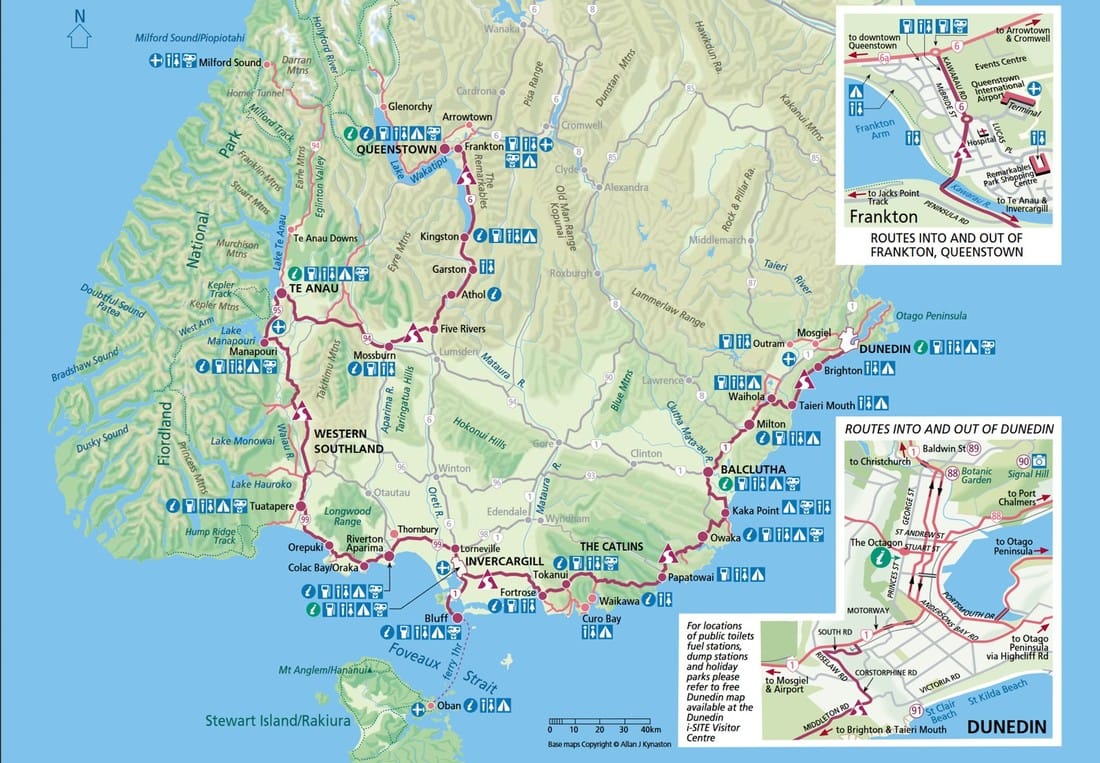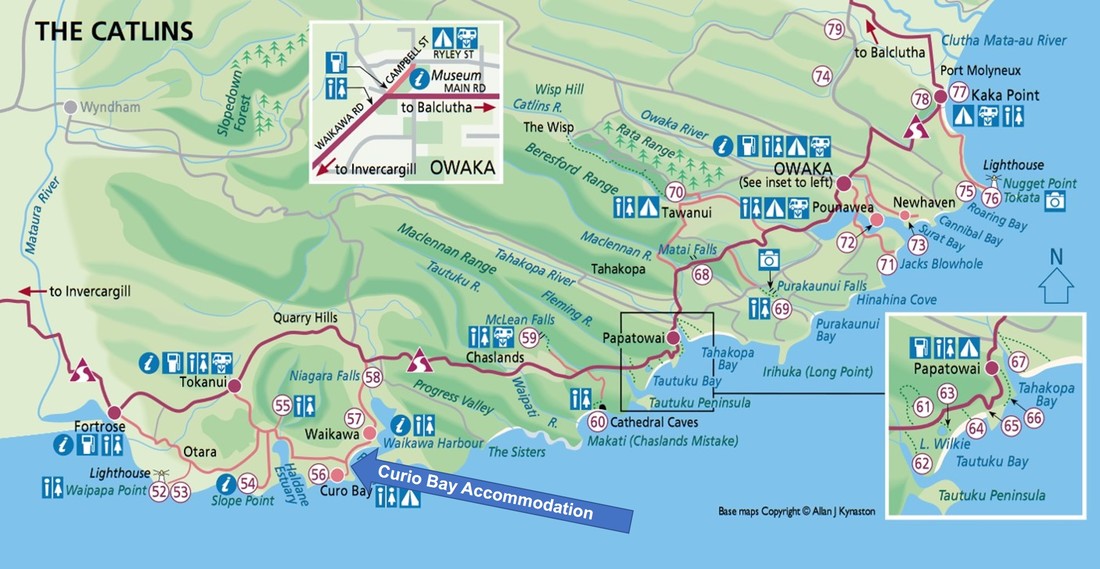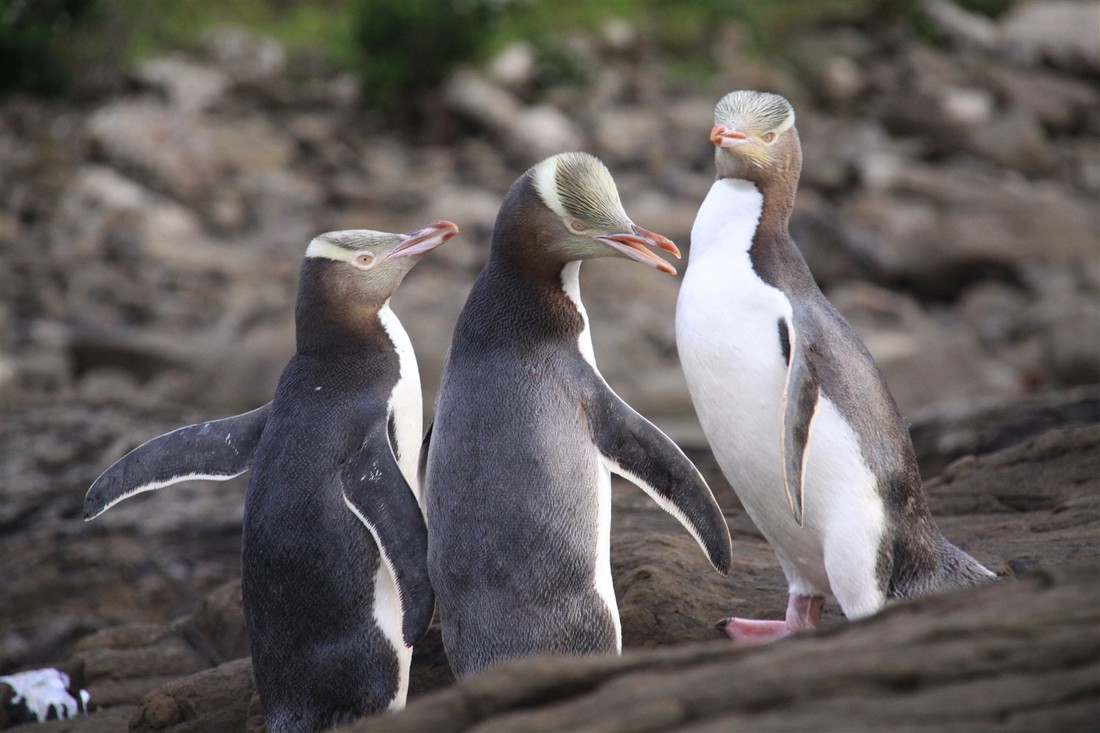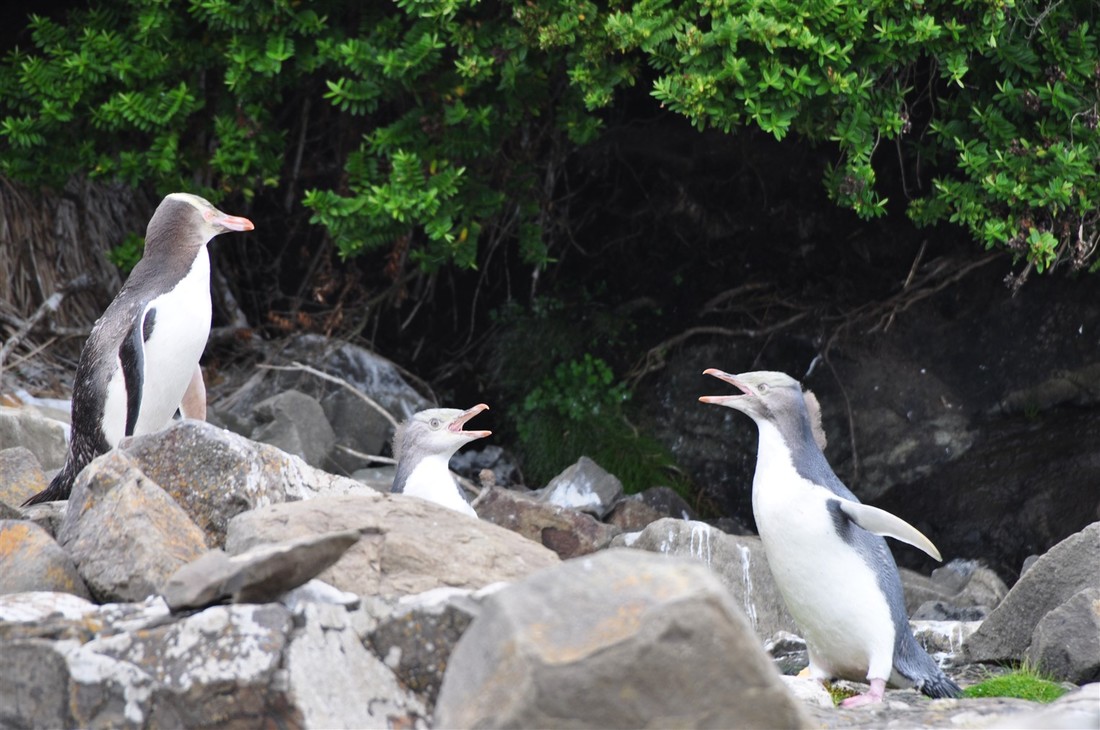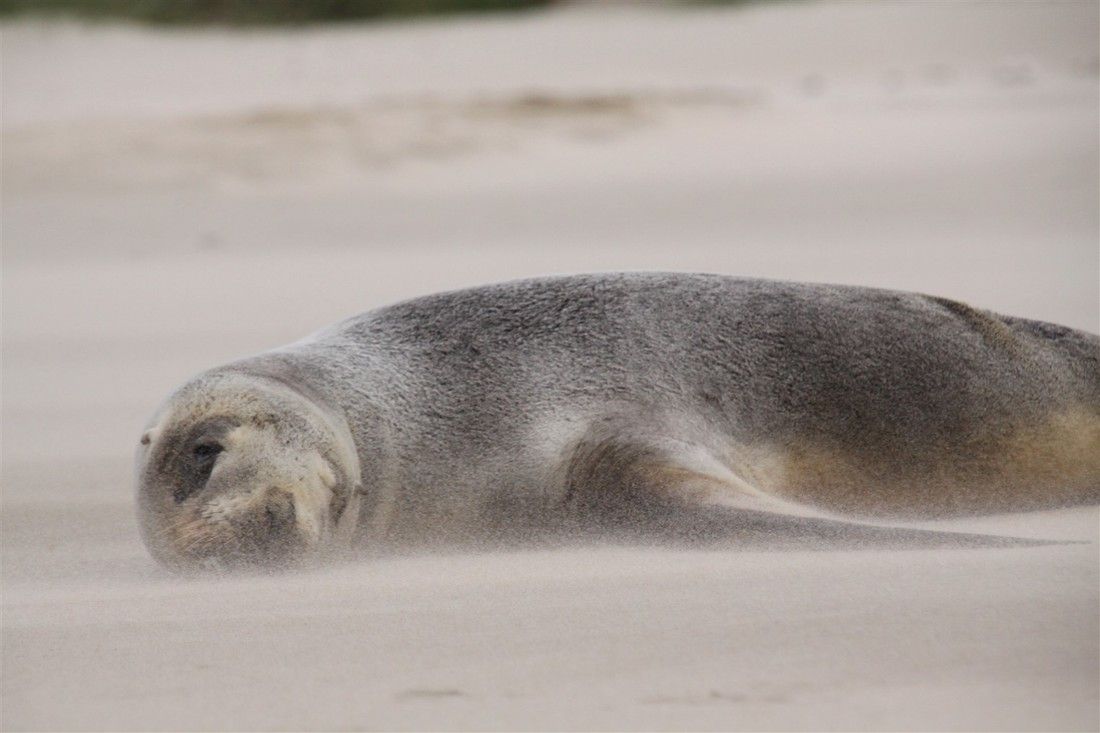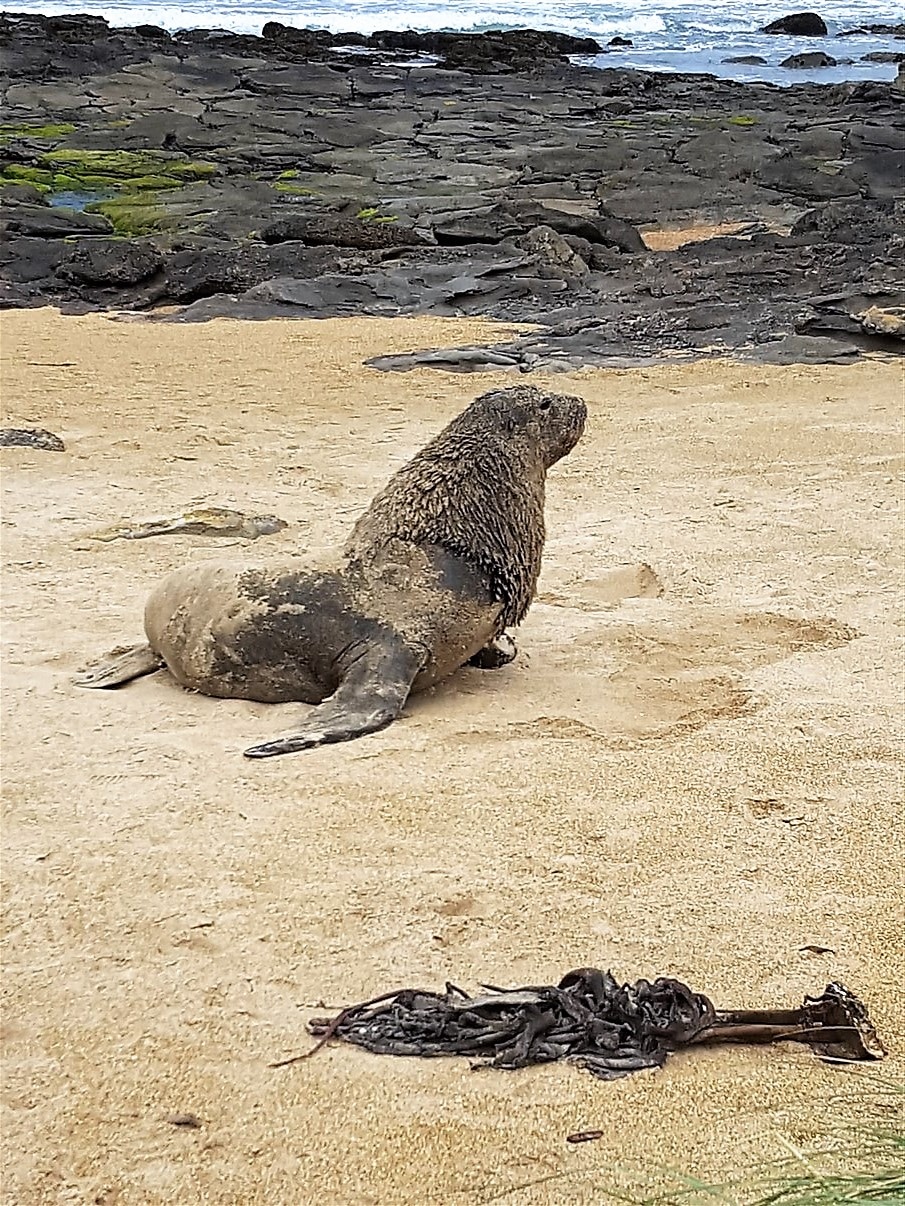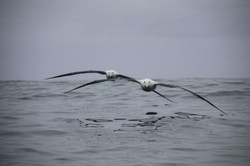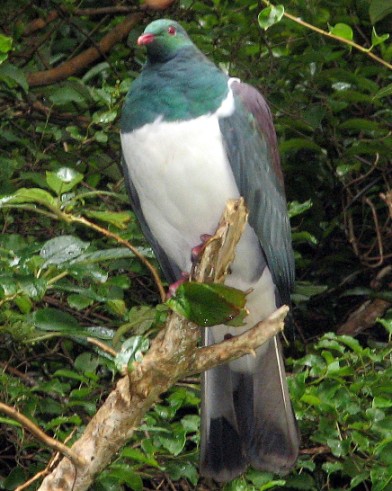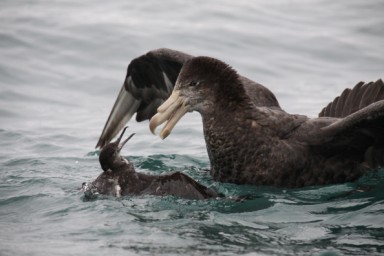Curio Bay - Catlins
Welcome to Curio Bay, located on the Southern Scenic Route and one of the most spectacular areas in New Zealand, well off the beaten track. It's a place of unique and rare wildlife and attractions such as the Petrified Forest.
Below is more detailed information on Curio Bay.
Below is more detailed information on Curio Bay.
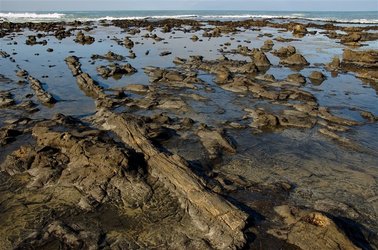 Petrified (fossil) forest at Curio Bay - click to enlarge
Petrified (fossil) forest at Curio Bay - click to enlarge
Petrified (fossil) Forest
The fossilised remains of an ancient forest is exposed at Curio Bay during low tide. This is one of the most extensive and least disturbed examples of a Jurassic fossil forest in the world and stretches about 20 kms from Curio Bay south west to Slope Point.
180 million years ago the Curio Bay area was a broad forested coastal floodplain. During this time, (known as the middle Jurassic period), New Zealand was part of the eastern margin of the ancient super-continent known as Gondwana. North of Curio Bay, most of future New Zealand was beneath the sea.
The forest predominantly consisted of trees forming a low canopy over an undergrowth dominated by ferns.
Massive sheet floods of volcanic debris, perhaps triggered by heavy rain on a barren volcanic mountain, are believed to have destroyed the forest. The forest eventually grew back only to again be flooded by volcanic debris. This happened at least four times over a period of about 20,000 years. The sequence of events is clearly recorded by distinct bands of fossilised tree stumps and wood exposed today in the cliff face.
In the millions of years, since the sediments were buried deeply and impregnated over time with silica minerals, eventually turning the wood to rock. In some places fern fronds and leaves have been preserved as fossils within the mudstone rocks.
About 100 million years ago New Zealand split away from Gondwana and slowly drifted north.
Over the last 10,000 years New Zealand’s current coast line has been formed and the sea has eroded away the layers of sandstone and clays - exposing tree stumps and logs.
This internationally important site can be explored at low tide. Souvenir hunters have removed some of these rare fossils over the years and this practice is discouraged. Leave the fossil forest undisturbed for others to enjoy.
A viewing platform and information panel has been provided overlooking the fossil forest.
The fossilised remains of an ancient forest is exposed at Curio Bay during low tide. This is one of the most extensive and least disturbed examples of a Jurassic fossil forest in the world and stretches about 20 kms from Curio Bay south west to Slope Point.
180 million years ago the Curio Bay area was a broad forested coastal floodplain. During this time, (known as the middle Jurassic period), New Zealand was part of the eastern margin of the ancient super-continent known as Gondwana. North of Curio Bay, most of future New Zealand was beneath the sea.
The forest predominantly consisted of trees forming a low canopy over an undergrowth dominated by ferns.
Massive sheet floods of volcanic debris, perhaps triggered by heavy rain on a barren volcanic mountain, are believed to have destroyed the forest. The forest eventually grew back only to again be flooded by volcanic debris. This happened at least four times over a period of about 20,000 years. The sequence of events is clearly recorded by distinct bands of fossilised tree stumps and wood exposed today in the cliff face.
In the millions of years, since the sediments were buried deeply and impregnated over time with silica minerals, eventually turning the wood to rock. In some places fern fronds and leaves have been preserved as fossils within the mudstone rocks.
About 100 million years ago New Zealand split away from Gondwana and slowly drifted north.
Over the last 10,000 years New Zealand’s current coast line has been formed and the sea has eroded away the layers of sandstone and clays - exposing tree stumps and logs.
This internationally important site can be explored at low tide. Souvenir hunters have removed some of these rare fossils over the years and this practice is discouraged. Leave the fossil forest undisturbed for others to enjoy.
A viewing platform and information panel has been provided overlooking the fossil forest.
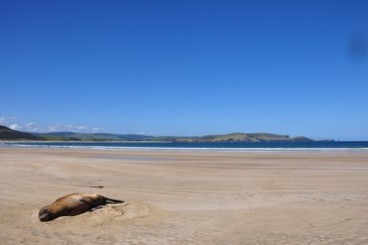 Seal resting on the beach
Seal resting on the beach
Wildlife at Curio Bay
Curio Bay offers some of the most spectacular and accessible wildlife opportunities in New Zealand. Humans can be a threat to the wildlife and it is therefore important you observe the following 'rules'.
Caring for wildlife
Do not feed the dolphins. When swimming or kayaking do not approach them - they will come to you if they want to. Always enter the water at least 50 metres away from any dolphin. They have sensitive skin so don't touch them.
All dogs should be kept well clear of areas inhabited by penguins, seals and sea lions.
Seals and sea lions may look placid but they are powerful, wild predators and can be very dangerous if they are approached too closely - keep at least 30 metres away. Do not disturb pups.
It is an offence to disturb or harass any native wildlife.
Curio Bay offers some of the most spectacular and accessible wildlife opportunities in New Zealand. Humans can be a threat to the wildlife and it is therefore important you observe the following 'rules'.
Caring for wildlife
Do not feed the dolphins. When swimming or kayaking do not approach them - they will come to you if they want to. Always enter the water at least 50 metres away from any dolphin. They have sensitive skin so don't touch them.
All dogs should be kept well clear of areas inhabited by penguins, seals and sea lions.
Seals and sea lions may look placid but they are powerful, wild predators and can be very dangerous if they are approached too closely - keep at least 30 metres away. Do not disturb pups.
It is an offence to disturb or harass any native wildlife.
|
Hector Dolphins
One of the smallest and the rarest of marine dolphins in the world, Hector's dolphins grow no more than 1.5 m in length. Only found in New Zealand's waters, this distinctive grey dolphin with black and white markings and a round dorsal fin is the most easily recognised species of dolphin in New Zealand. |
|
|
Yellow-eyed penguin/hoiho
Several hoiho or yellow-eyed penguins nest in the area around Curio Bay/Waikawa. They are one of the rarest penguins in the world with an estimated total population in New Zealand of between 6000 and 7000. The population has declined because of the clearance of coastal forest in which the penguins nest. They are also affected by introduced predators such as stoats, ferrets and dogs, while stock may disturb their nests. Eggs are laid in September/October and both parents incubate and help rear chicks. Birds usually leave the nest for the sea early in the morning, returning late afternoon/early evening. The penguins moult between February and April when they are particularly vulnerable to disturbance. Take care: Yellow-eyed penguins are very timid birds and will either leave the area or 'freeze' at the sight of people and dogs. All dogs should be kept well clear of the areas inhabited by penguins. |
|
New Zealand fur seal and sea lion
New Zealand fur seals and sea lions regularly haul themselves out of the water along the Catlins coastline. Both species spend considerable time ashore with seals usually found on rocky shorelines and sea lions on sandy beaches. The New Zealand fur seal was hunted early last century for skins until no colonies were left on the mainland. The population is now estimated to be around 50,000 - a quarter of the original population. Take care: Adult fur seals sometimes leave pups on the beach while they are away fishing. The pups should not be disturbed. Male sea lions may be very aggressive during December - February which is their breeding season. For safety keep at least 30 metres away from sea lions. Dogs and people are seen as a threat by seals and sea lions, particularly if their escape route to the sea appears to be blocked. Although they may look placid they are powerful, wild predators and can be very dangerous if they are approached too closely. All dogs should be kept well away from seals and sea lions. |
|
Other wildlife
Blue penguins nest in burrows around Porpoise Bay while Stewart Island shags can be seen on rock stacks below the headland. Albatrosses fly over the sea and muttonbirds/tītī can be seen in groups off shore. White-fronted terns can also be seen around the bays. Birds of the Native Rainforests The native rainforests of the Catlins still support good numbers of common New Zealand native forest birds such as kereru (pigeon), tui, korimako (bellbird), pipipi (brown creeper), riroriro (grey warbler), miro miro (tomtit), ruru (morepork) and piwakawaka (fantail). There are also some of the rare native bush birds such as kakariki (parakeet), kaka, titipounamu (rifleman), karearea (falcon) and mohua (yellowhead) to be seen. On the western and northern borders of the Catlins’ forests, the drier and colder climate limits tree growth and the forests give way naturally to shrubland and tussock grassland. Birds of the Estuaries and the Sea The estuaries of the Catlins are rich in bird life. Wading birds commonly seen are kaki (stilt), torea (oystercatcher – 2 species), herons (2 species), tuturiwhatu (dotterel), plovers, kuaka (godwit) as well as gulls, tara (tern – 2 species), at least 3 species of duck, and kotare (kingfisher). Other sea birds to look out for include shags, sooty shearwaters and crested spoonbills. |
Curio Bay Accommodation - Nick & Dani Stratford
521A Waikawa - Curio Bay Road / South Catlins - New Zealand
Ph +64 3 2468 797
email: [email protected]
521A Waikawa - Curio Bay Road / South Catlins - New Zealand
Ph +64 3 2468 797
email: [email protected]

